Family : Ovulidae

Text © Dr Domenico Pacifici

English translation by Mario Beltramini
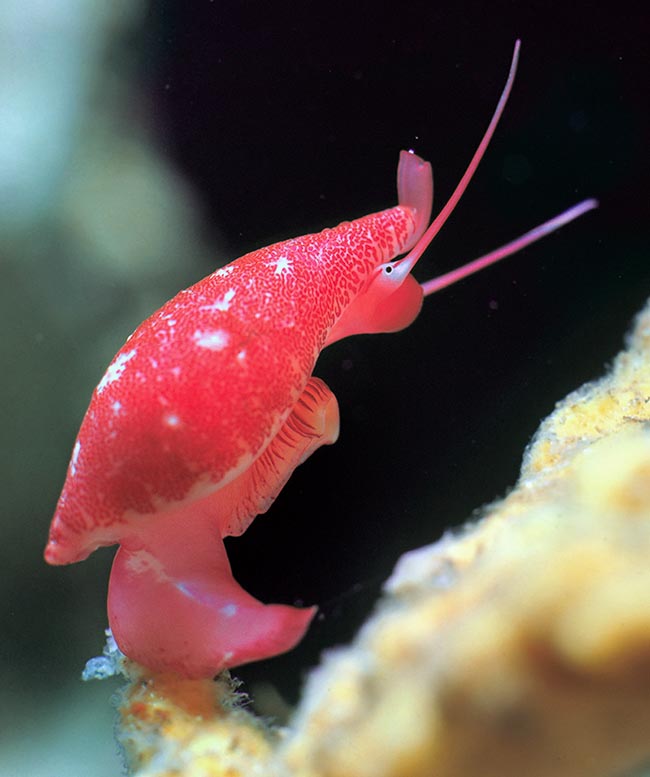
Once considered endemic to Mediterranean, Simnia spelta has been recently seen also also in eastern Atlantic, from Spain, on the Galician coast and in the Gulf of Biscay, in the Canary Islands and even in Angola © Giuseppe Mazza
Simnia spelta Linnaeus, 1758 is a marine gastropod belonging to the family Ovulidae, that counts 74 genera.
The name Simnia is an abbreviation of the Greek word “σκύμνια” (scymnia) = curl, whilst spelta refers to the shape of the fruit of the common wheat Triticum aestivum var. spelta Linnaeus, 1758 from which gets the name.
Zoogeography
For a long time it was considered an exclusively European endemic species, with a biggest concentration in some zones of the Adriatic Sea and in the basin of western Mediterranean.
However, in the early 2000s, began a series of findings also in the Atlantic Ocean, in Spain, on the Galician coast and in the Gulf of Biscay, in the Canary Islands and in Angola.
Ecology-Habitat
This small mollusc is a specialist predator of polyps of gorgonians of the genus Eunicella, Paramuricea and Lophogorgia.
It nourishes also of the gorgonians coating connective tissue that it grazes slowly with its spiny tongue, a typical organ of the molluscs that takes the name of radula.
It spends almost all its life in the gorgonians it eats, at a maximum depth of 10 m.
Morphophysiology
Simnia spelta is a very small gastropod having a maximum size of 2 cm, but has a robust coriaceous shell of tapered shape, pointed on the two extremities and slightly swollen in the middle, characterized by an opening that runs along the entire lower part of the body.
The shell is glossy white, tending to salmon and may be covered by the mantle of the animal when extended.
This particular eversion of the mantle is usually observed in another well-known family of molluscs, the Cypraeidae, with which it is easy to mistake also for the conformation of the shell itself.
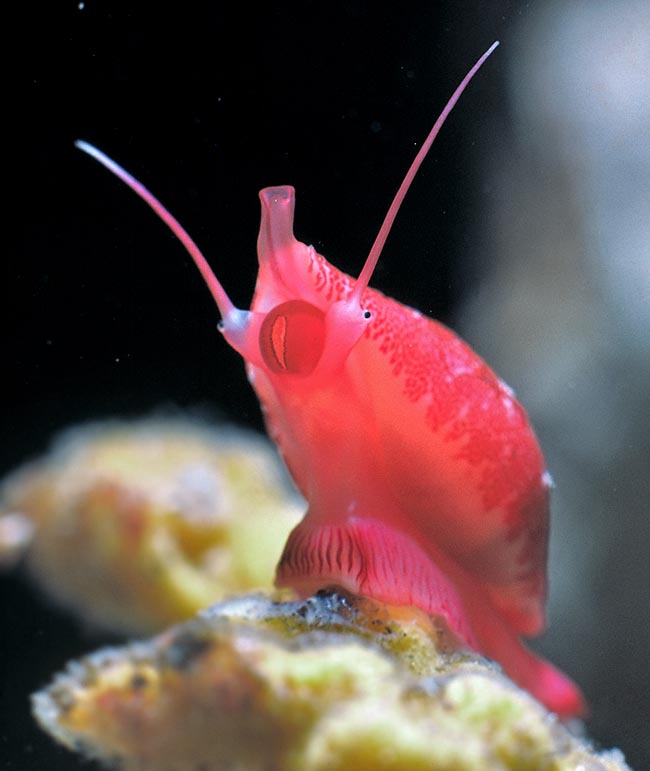
Here in frontal position. Well visible are the respiratory sifon that carries water to the gills, the radula and the eyes, placed at the base of two long mobile expansions that have chemoreceptor organs to analyze the environment © Giuseppe Mazza
It is not by chance that both families (Ovulidae and Cypraeidae) have been grouped under one only Superfamily that gets the name of Cypraeoidea.
The mantle always reminds the speckings and the marbling streaks of the gorgonia where the animal grows, thus rendering this mollusc very cryptic and difficult to find for the predators.
This is possible because the pigments of the gorgonian are held back in the tissues of the mollusc, after having grazed the connective layer of the gorgonia to which it belongs.
The head, besides the radula, has two long and well visible expansions on which stand the eyes of black colour, the only colour that differs from the rest of the body, and chemoreceptor organs specialized in analyzing the surrounding environment.
The head is surmounted by the respiratory siphon formed by a membranous lamina folded back on itself to form a tube.
The function of the siphon is that of sucking the surrounding water that will go to sprinkle the gills of the mollusc, the ctenidia or comb-shaped gills.
The particular conformation of the gills allows the water to move in well precise directions and in this way to maximize the absorption of oxygen.
Ethology-Reproductive Biology
The individuals of this species have distinct sexes and the fecundation is internal.
The eggs are laid on the branches of the gorgonians and, in order to facilitate their concealment, they have the same colour as the gorgonians they belong to.
The ovigerous capsules have the diametre of a couple of millimetres and are laid around the ramifications of the Gorgonians.
Each capsule contains about ten eggs that when just laid are whitish but later on, with the progress of the embryonic development, become brown-reddish.
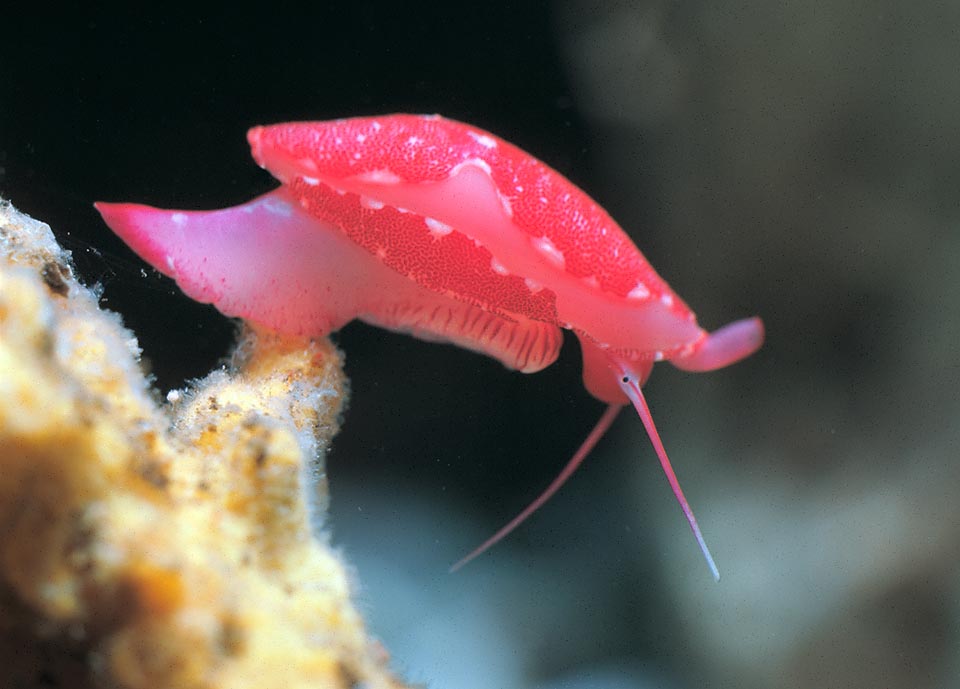
To note the foot and the extending mantle. As for the Cypraeidae, grouped to the Ovulidae in the Cypraeoidea Superfamily, it can cover the shell also here © Giuseppe Mazza
The embryos develop in planktonic larvae and later on go through a juvenile stage called veliger, before becoming adults.
The veliger is a planktonic stage very diffused among the gastropods. The larva is equipped with a small shell, a foot, eyes and a particular laminar preoral expansion surrounded by cilia called velum, with which the larva may stand suspended in water and convey the food particles to the mouth.
Simnia spelta is by sure one of the gastropods most known, even if unconsciously, by lovers and not of the sector.
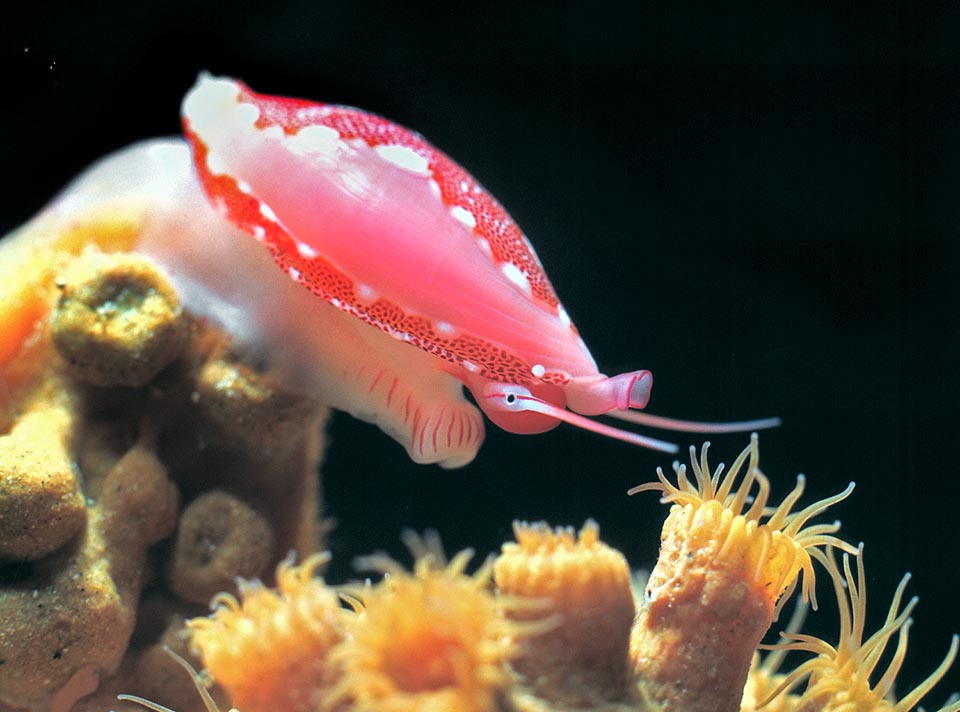
Simnia spelta is a tiny gastropod reaching a maximum of 2 cm. The coriaceous shell, tapered, pointed at both extremities, is characterized by an opening running along the entire lower part of the body. It is glossy white tending to salmon, whilst the mantle assumes, incorporating its pigments, the colour of the gorgonians on which it grazes © Giuseppe Mazza
Not infrequently, in fact, it is possible to see its glossy shell adorning necklaces and bracelets sold in the European beaches, a phenomenon that has increased its popularity even among the simple bathers.
In the sixties the difficult finding of the specimens, united to an ever-bigger request of the shell, led to a rapid impoverishment of the beaches so much that its inexorable extinction was believed.
However, when the practice of scuba diving became amateur, it was more common to observe this species in its own natural environment, together with other species with an equal number of unique and fascinating shells.
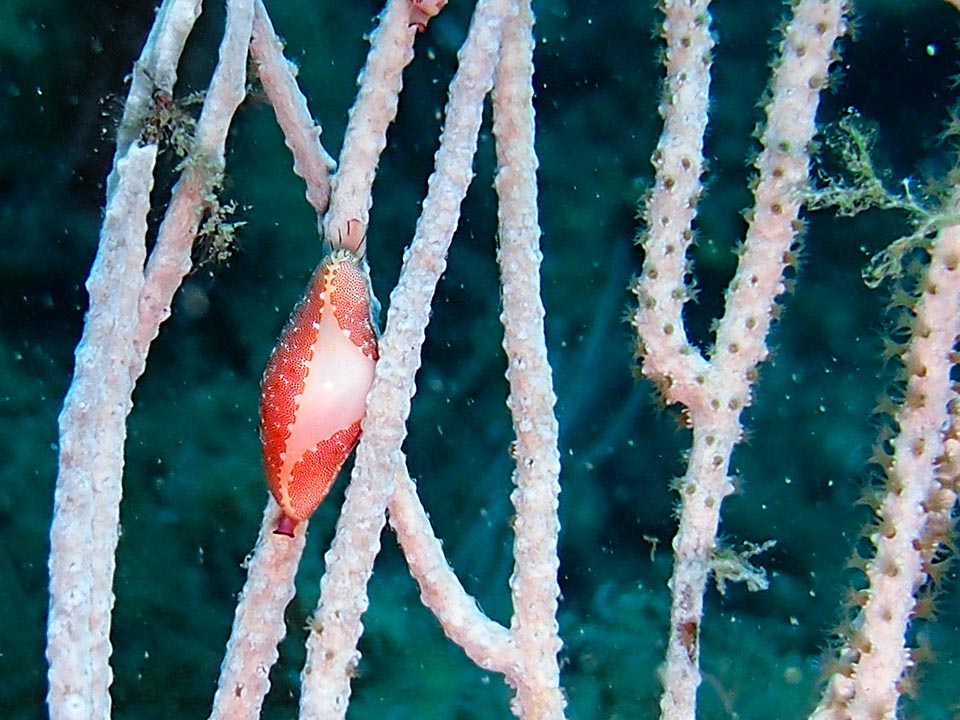
Here it is busy feeding on a white gorgonia. Once sought after for necklaces, Simnia spelta nowadays is not an endangered species © Laurent Toulouse
This led, as it is easy to guess, to a general loss of interest towards the shells as ornamental embellishment as now they did not have any more that aura of rarity that had distinguished them so much up to that moment. Simnia spelta has consequently returned to being a thriving species, and for the moment its extinction appears to be averted.
Synonyms
Bulla spelta Linnaeus, 1758; Neosimnia spelta Linnaeus, 1758; Simnia nicaeensis Risso 1826; Ovulum secale Sowerby 1828; Ovula sowerbyana sensu Tryon, 1885 not Weinkauff, 1881; Ovula spelta var. lutea-roseocarnea Bucquoy, Dautzenberg & Dollfus, 1883; Ovula acicularis Tryon 1885; Ovula intermedia Tryon 1885; Ovula sowerbyana Tryon 1885; Ovula obsoleta Locard, 1891; Ovula spelta var. lutea Pallary 1900; Simnia spelta var. brevis Coen 1949.
→ To appreciate the biodiversity within the MOLLUSCS please click here.
